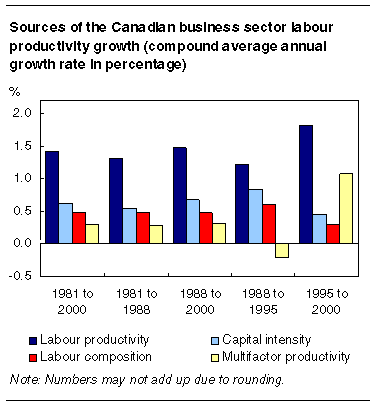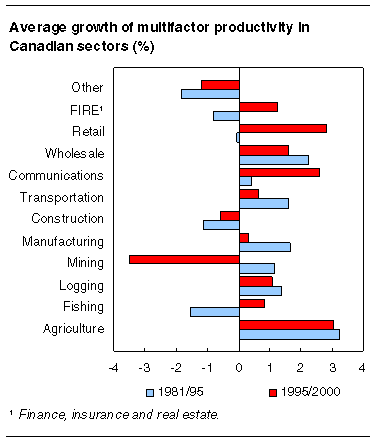
















 |
|
 |                |
Information identified as archived is provided for reference, research or recordkeeping purposes. It is not subject to the Government of Canada Web Standards and has not been altered or updated since it was archived. Please "contact us" to request a format other than those available.

|

Friday, July 12, 2002 Multifactor productivity growth2001Multifactor productivity in the business sector slipped in 2001 for the first time in five years. The business sector recorded a slight 0.1% decline, compared with a growth rate of 1.7% in 2000. This was the smallest decline in multifactor productivity during any economic downturn of the last two decades. It had not declined since 1996, when it fell 0.7%. Multifactor productivity is designed to measure the joint influences on economic growth of technological change, efficiency improvements, returns to scale and other factors. Its growth rate is calculated as the difference between the growth in the amount of output produced (real gross domestic product) and the growth of the quantity of all inputs used, such as labour and machinery and equipment. A second measure, labour productivity, is the output per unit of labour. This measure does not consider other important factors such as capital. Inputs of capital and labour grow at faster pace than outputThe decline in multifactor productivity in 2001 reflected the fact that the growth rate of inputs of capital and labour slightly outpaced that of output. The business sector recorded a 0.9% increase in output in 2001, and a 1% increase in the combined inputs of capital and labour.
The opposite was true in 2000, when output grew 5.4%, but combined inputs rose only 3.7%. This produced a 1.7% multifactor productivity growth rate. In 2001, capital increased 1.8%, the slowest rate of growth since 1993, when it was 0.9%. This contrasts with the late 1990s, when capital recorded an annual average growth rate of 4.6%. The slowdown in the growth of capital is partly attributable to information technology (including computer hardware, software and communications capital), which grew 5.9%, well below the 32.1% rate in 2000. Other capital assets such as other machinery and equipment and structures, which account for the bulk of capital, showed a less remarkable slowdown (from 4% to 1.1% for other machinery and equipment and from 2.1% to 1.5% for structures). After a remarkable increase during the late 1990s, the increase in hours at work stalled in 2001. Labour input grew 0.4% in 2001, its smallest increase since 1992. Labour input reflects the change in hours at work, adjusted for the effects of changing labour composition in terms of shifts in the experience and education of the workforce. As is typical during periods of economic slowdown, labour composition fuelled a substantial proportion of the increase in labour input in 2001. Analysis of year-over-year growth in productivity reveals an irregular pattern. Sharp increases such as the one recorded in 1999 are often followed by lower increases, such as the one that occurred in 2000. This is because unanticipated fluctuations in output often lead to delays in the adjustment of the inputs. Erratic fluctuations in yearly estimates of productivity performance need, therefore, to be averaged to display the underlying long-term trends in the data. Canada's multifactor productivity experience: a major revival in the late 1990sLabour productivity growth can be decomposed into three components: multifactor productivity growth, the contribution of increased capital intensity, and the contribution of shifts in labour composition towards more highly skilled workers. 
Over the last 20 years, capital has grown more rapidly than hours in the private business sector. The skills of workers, as measured by their education and work experience, have also risen over this period. These shifts toward more capital-intensive production and workers with more human capital have allowed output per hour to grow at a faster rate than multifactor productivity growth. From 1981 to 2000, labour productivity grew at an average annual rate of 1.4% in the business sector. Of this 1.4%, 0.3 percentage points are attributed to increases in multifactor productivity, 0.6 percentage points to the contribution of increases in capital intensity, and 0.5 percentage points to changes in the contribution of labour composition. The contribution of capital intensity is composed of the contribution of information technology (0.4 percentage points) and of the contribution of other types of capital (0.2 percentage points). The size of these components was quite similar over the 1980s and 1990s. Labour productivity increased at an annual average of 1.5 % during the 1988-2000 period, slightly faster than during the 1981-1988 period (1.3%). During the 1988-2000 period, growth in both multifactor productivity (0.3 percentage points) and labour composition (0.5 percentage points) remained unchanged from the 1981-1988 period. The contribution of increases in capital intensity inched up, from 0.6 percentage points in 1981-1988 to 0.7 percentage points in 1988-2000; this change is partly the result of the increasingly important role of information technology, which accounted for nearly two-thirds of the growth in the contribution of capital intensity. In the 1990s, there were two quite distinct subperiods. Output per hour grew only 1.2% per year during the 1988-1995 period. From 1995 to 2000, output per hour increased 1.8% per year, 0.6 percentage points more than in the previous period. This acceleration is attributed entirely to faster multifactor productivity growth, which increased from -0.2 percentage points in the 1988-1995 period to 1.1 percentage points in the late 1990s. Increases in capital intensity and labour composition, the other sources of labour productivity growth, both declined. Their contributions fell from 0.8 to 0.5 percentage points, and from 0.6 to 0.3 percentage points, respectively. Since The Daily release of March 1, the Canadian estimates have been slightly revised, and the US numbers have been updated to 2000; but the story of a remarkable resurgence in Canadian performance relative to the United States remains unchanged. Over the entire period from 1981 to 2000, Canada lagged behind the United States (0.3% compared to 0.9%), but Canada's multifactor productivity revival in the late 1990s compared with the early 1990s was more robust (an increase of 1.3 percentage points in Canada compared with an increase of 0.9 percentage points in the United States). 
Industry sources of Canada's productivity revivalThe multifactor productivity growth revival during the late 1990s was not confined to only one sector. There was a strong productivity revival after 1995 in many major sectors of the Canadian economy - in retail trade, communications and utilities, as well as in finance, insurance and real estate. But two important sectors, manufacturing and wholesale, experienced a slowdown in their productivity growth during the late 1990s. The turnaround has been particularly large in those industries that are heavy users of information and communications technologies. Information technology has facilitated productivity gains through the use of new processes and the restructuring of businesses. Available on CANSIM: tables 383-0001 and 383-0007. To order data, contact productivity.measures@statcan.gc.ca. For more information, or to enquire about the concepts, methods or data quality of this release, contact Tarek M. Harchaoui (613-951-9856; fax: 613-951-5403; harctar@statcan.gc.ca), Micro-economic Analysis Division.
| ||||||||||||||||||||||||||||||||||||||||||||||||||||||||||||||||||||||||||||||||||||||||||||||||||||||||||||||||||||||||||||||||||||||||||||||||||||||||||||||||||||||||||||||||||||||||||||||||||||||||||||||||||||||
|
|
|